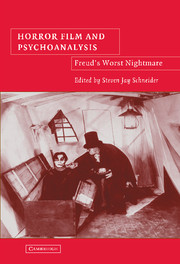Book contents
- Frontmatter
- Contents
- Acknowledgments
- Foreword: “What Lies Beneath?”
- Introduction: “Psychoanalysis in/and/of the Horror Film”
- PART ONE THE QUESTION OF HORROR-PLEASURE
- 1 “What's the Matter with Melanie?”: Reflections on the Merits of Psychoanalytic Approaches to Modern Horror Cinema
- 2 A Fun Night Out: Horror and Other Pleasures of the Cinema
- 3 Excerpt from “Why Horror? The Peculiar Pleasures of a Popular Genre,” with a New Afterword by the Author
- 4 Philosophical Problems Concerning the Concept of Pleasure in Psychoanalytical Theories of (the Horror) Film
- PART TWO THEORIZING THE UNCANNY
- PART THREE REPRESENTING PSYCHOANALYSIS
- PART FOUR NEW DIRECTIONS
- Afterword: Psychoanalysis and the Horror Film
- About the Contributors
- Bibliography
- Index
2 - A Fun Night Out: Horror and Other Pleasures of the Cinema
Published online by Cambridge University Press: 14 July 2009
- Frontmatter
- Contents
- Acknowledgments
- Foreword: “What Lies Beneath?”
- Introduction: “Psychoanalysis in/and/of the Horror Film”
- PART ONE THE QUESTION OF HORROR-PLEASURE
- 1 “What's the Matter with Melanie?”: Reflections on the Merits of Psychoanalytic Approaches to Modern Horror Cinema
- 2 A Fun Night Out: Horror and Other Pleasures of the Cinema
- 3 Excerpt from “Why Horror? The Peculiar Pleasures of a Popular Genre,” with a New Afterword by the Author
- 4 Philosophical Problems Concerning the Concept of Pleasure in Psychoanalytical Theories of (the Horror) Film
- PART TWO THEORIZING THE UNCANNY
- PART THREE REPRESENTING PSYCHOANALYSIS
- PART FOUR NEW DIRECTIONS
- Afterword: Psychoanalysis and the Horror Film
- About the Contributors
- Bibliography
- Index
Summary
Psychoanalytic theories of film, and of the horror film in particular, have been subject to attack from various quarters. This essay responds to these attacks, defending a psychoanalytic approach to horror cinema from objections raised by theorists such as Stephen Prince, Andrew Tudor, Jonathan Crane, Noël Carroll, and Berys Gaut. Some of these objections do little more than wheel out the familiar charge – a common one even in Freud's time – that psychoanalysis is “unscientific.” But even if it is true that psychoanalysis is unscientific (by some often objectionable standard), this does not ipso facto show that it is false. Adolf Grünbaum's critique of Freud's so-called Tally Argument (see below) is an example of one such “objectionable standard.” This critique is basically a gussied-up version of the claim that psychoanalysis is not falsifiable. However, the falsifiability (in principle) of a scientific theory has to be interpreted in a way suitable to the theory in question. It is clear that psychoanalysis is not going to be falsifiable (in principle) in the way that the physical or biological sciences are – that is, by producing an experiment that can conclusively falsify it. Nevertheless, as I will argue, aspects of psychoanalysis certainly are falsifiable, and indeed have been falsified.
It is also not difficult to produce examples of disciplines and theories that are (by certain standards) unscientific but true, or likely to be true.
- Type
- Chapter
- Information
- Horror Film and PsychoanalysisFreud's Worst Nightmare, pp. 35 - 54Publisher: Cambridge University PressPrint publication year: 2004
- 6
- Cited by

